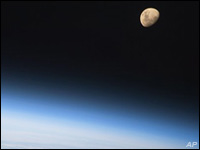
Roughly a year after water molecules were first discovered on the moon, scientists last week announced that water is present in much greater quantities there than had originally been thought.

Specifically, not only is the soil within the moon’s shadowy craters “rich in useful materials” — including pure ice crystals — but the moon is chemically active and even has a water cycle, NASA announced on Thursday.
The findings derive from a full analysis of the plume of debris that resulted last fall when NASA’s Lunar CRater Observation and Sensing Satellite, or LCROSS, and a spent rocket stage went hurtling into the Cabeus crater at the Moon’s south pole. The LCROSS probe gathered imagery and other data while another spacecraft — NASA’s Lunar Reconnaissance Orbiter (LRO) — studied the plume from nearby.
The results of the new analysis are featured in six papers published in the Oct. 22 issue of the journal Science.
Pockets of Ice
When the impact’s plume of debris traveled nearly 10 miles above the rim of Cabeus, instruments aboard LCROSS and LRO made observations of the crater and debris and vapor clouds. After the impacts, grains of mostly pure water ice were lofted into the sunlight in the vacuum of space.
“Seeing mostly pure water ice grains in the plume means water ice was somehow delivered to the moon in the past, or chemical processes have been causing ice to accumulate in large quantities,” said Anthony Colaprete, LCROSS project scientist and principal investigator at NASA’s Ames Research Center.
Water is not uniformly distributed within the shadowed cold traps, scientists have concluded, but rather is in pockets, which may also lie outside the shadowed regions.
A Silvery Moon – Literally
The diversity and abundance of materials known as “volatiles,” meanwhile, “suggest a variety of sources, like comets and asteroids, and an active water cycle within the lunar shadows,” Colaprete added.
Volatiles are compounds that freeze and are trapped in the cold lunar craters and vaporize when warmed by the sun. As much as 20 percent of the material kicked up by the LCROSS impact was volatiles, including methane, ammonia, hydrogen gas, carbon dioxide and carbon monoxide.
Also present in significant amounts were light metals such as sodium, mercury and possibly even silver, the scientists found.
10 Times More Water
The new analysis actually suggests that there’s about 10 times more water than had originally been thought, Paul Czysz, professor emeritus of aerospace engineering at St. Louis University, told TechNewsWorld.
What that means is that there may be a potential for mining water on the moon, which would solve all sorts of existing problems there when it comes to supporting human life.
For example, while many imagine astronauts using dehydrated food, Czysz noted — lighter and easier as it may be for transportation — the fact remains that one must still have water on board to reconstitute it. Were there usable water on the moon, however, that extra weight could be avoided.
Some 43,000 pounds of food and water are required to keep just one person alive in orbit for a year, Czysz estimated.
‘A Little Robotic Factory’
Of course, getting that water will take some effort. It’s not just a matter of digging a hole and finding it, he noted — rather, specialized equipment would be required to prevent sublimation, by which ice would turn directly into a gas and disappear.
Still, it’s within the realm of possibility, he added. “We can put in a little robotic factory that basically takes water out and stores it,” he explained.
While some have suggested the possibility of lush hydrofarms on the moon, however, that’s not possible, Czysz said.
‘Cold as Heck’
“There isn’t enough gravity to hold a productive atmosphere,” he explained. “It’s the same on Mars.”
Still to be determined, meanwhile, are whether the water deposits are found only on the moon’s south pole, or whether the north pole and dark side might harbor some too. Those portions, in fact, see less sunlight and so could be even better sources.
The dark side, however, is “very rugged and cold as heck,” Czysz said, noting that temperatures are typically between -240F and -260F.
In other words, he concluded, “you’d better have your hand warmers.”





















































